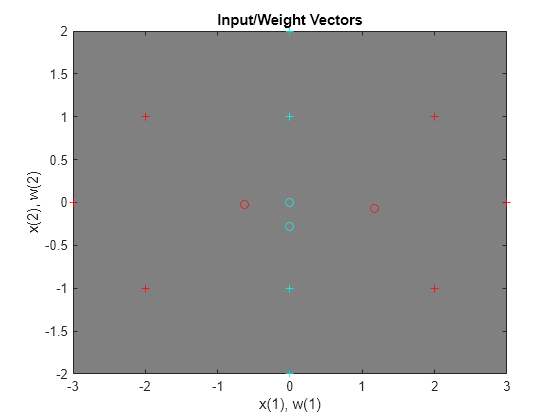このページの内容は最新ではありません。最新版の英語を参照するには、ここをクリックします。
学習ベクトル量子化
特定のターゲットに応じて入力ベクトルを分類するように、LVQ ネットワークの学習を行います。
X を 10 個の 2 要素標本の入力ベクトル、C をこれらのベクトルが分類されるクラスとします。これらのクラスは IND2VEC でベクトルに変換して、ターゲット T として使用します。
x = [-3 -2 -2 0 0 0 0 +2 +2 +3;
0 +1 -1 +2 +1 -1 -2 +1 -1 0];
c = [1 1 1 2 2 2 2 1 1 1];
t = ind2vec(c);次に、データ点をプロットします。赤 = クラス 1、シアン = クラス 2 です。LVQ ネットワークは、隠れニューロンのあるベクトルのクラスターを表し、出力ニューロンのあるクラスターをグループ化して目的のクラスを形成します。
colormap(hsv); plotvec(x,c) title('Input Vectors'); xlabel('x(1)'); ylabel('x(2)');

ここで、LVQNET によって、4 個の隠れニューロンがあり、学習率が 0.1 の LVQ 層が作成されます。次に、入力 X およびターゲット T に対してネットワークが構成されます (通常、構成は TRAIN によって自動的に行われるため、この手順は不要です)。
net = lvqnet(4,0.1); net = configure(net,x,t);
競合ニューロンの重みベクトルを以下のようにプロットします。
hold on w1 = net.IW{1}; plot(w1(1,1),w1(1,2),'ow') title('Input/Weight Vectors'); xlabel('x(1), w(1)'); ylabel('x(2), w(2)');

ネットワークの学習は、まず既定の数のエポックをオーバーライドした後に行います。完了したら、入力ベクトル '+' および競合ニューロンの重みベクトル 'o' を再プロットします。赤 = クラス 1、シアン = クラス 2 です。
net.trainParam.epochs=150; net=train(net,x,t);

cla; plotvec(x,c); hold on; plotvec(net.IW{1}',vec2ind(net.LW{2}),'o');

ここで、LVQ ネットワークを分類器として使用します。各ニューロンは異なるカテゴリに対応します。入力ベクトル [0.2; 1] を提示します。赤 = クラス 1、シアン = クラス 2 です。
x1 = [0.2; 1]; y1 = vec2ind(net(x1))
y1 = 2
